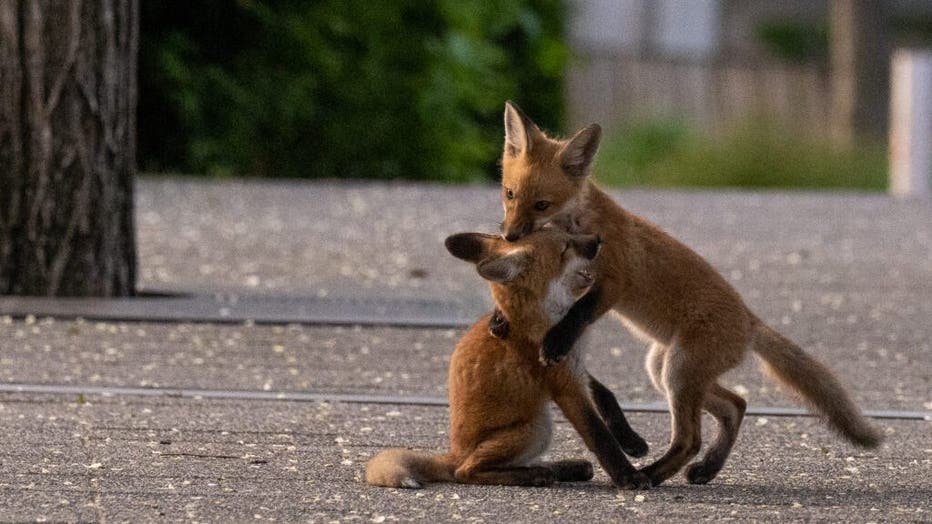Millennium Park fox family is the latest Chicago wildlife to go viral

Baby foxes move into spacious property at Millennium Park
A family of foxes has taken up residence in Millennium Park.
CHICAGO - They have become downtown Chicago's most popular new residents: a family of foxes that have made Lurie Garden at Millennium Park their home — and they are drawing an audience.
After stunning images of the Millennium Park foxes had spread across the internet on Tuesday afternoon, Millennium Park put up barriers hoping to give the family some space.
That’s probably a good thing because they have quickly become quite popular.
"They’re so cute," said Alejandra Stockton, who showed up hoping to catch a glimpse. "And to be honest, that's my favorite animal—foxes."
"Hopefully I can get a picture of at least two of them. Or one of them. Doesn't matter," said her husband, Aaron.
SUBSCRIBE TO FOX 32 ON YOUTUBE
Liza Lehrer with the Urban Wildlife Institute at Lincoln Park Zoo said, "It is incredibly exciting to see this family of foxes seemingly thriving down in Millennium Park."
Thriving—she said—because of the food supply. As omnivores, they feast on small mammals like birds, squirrels, mice — and yes, rats.
"They're probably feeding on rats and Chicago definitely has a healthy rat population, so there's plenty of those to go around and they're helping us out. They're keeping those rat populations down for us," said Lehrer.
Based on the photos, Lehrer estimates the kits are between six and eight weeks old, just old enough to leave the den, which the foxes likely built under a man-made structure within the Lurie Garden.
"It’s really neat to see them right in downtown Chicago, right in such a visible spot, doing regular red fox things: hunting, foraging, frolicking and playing. It's really great to see and exciting," she said.

Two fox kits play near their den in the Lurie Garden in Millennium Park, Monday, May 22, 2023. | Tyler Pasciak LaRiviere/Sun-Times
Lehrer said the foxes may have chosen the park as a home to avoid coyotes, which are thought to be their main competition for habitat. Coyotes prefer to stay in locations with lower human activity and have a lot of room to roam. Coyotes are also known to kill foxes to reduce their competition.
"We think the red foxes are kind of hanging out more in residential areas and certain pockets where they can avoid coyotes," Lehrer said. "And you know, Millennium Park might be one of those really great spaces, even though there’s more human activity there."
The foxes have probably figured out how to safely navigate the busy streets surrounding the park.
"We don’t know exactly when they’re crossing these roads, but maybe they’re finding times where the traffic is lower," Lehrer said. "They’re more active at night. So I suspect that they’re probably crossing those bigger roads later at night where the traffic is lower, and maybe they just sort of figured out the best times to do it."
Red foxes are typically smaller than coyotes, weighing 7 to 15 pounds, on average, and standing up to 20 inches at the shoulder. They are generally solitary and do not form packs.
They are native to the area but are only present in certain areas of the city and don’t have a high population count. It’s hard to get a good estimate on their total numbers because foxes are difficult to track, Lehrer said.
But a clue can be found in the institute’s biodiversity monitoring study, which has been going on for 13 years, Lehrer said. As part of the study, the institute keeps tabs on 100 locations in the Chicago area using trail cameras. Lehrer said a recent analysis of those sites found foxes present in about 13 of those locations.
The fox family is sure to join the list of viral Chicago critters in recent years. That list includes piping plover lovers Monty and Rose, massive snapping turtle "Chonkosaurus" and famed alligator "Chance the Snapper."
Lehrer said the furry family is just a small example of the diverse fauna that call the city home.
"There’s tons of different wildlife that live in Chicago, all kinds of mammals and birds and reptiles that, if you just kind of take a close look, you’ll really be able to see how biodiverse the Chicago area really is," Lehrer said.
She said if you do spot the foxes, observe and do not disturb, keep pets at a distance, and do not feed them. The last thing urban wildlife advocates want to see happen is for them to become dependent on humans for their food supply.
Sun-Times Media Wire contributed to this report.

